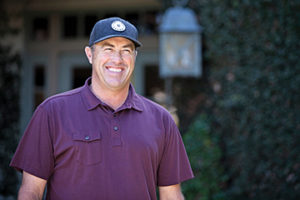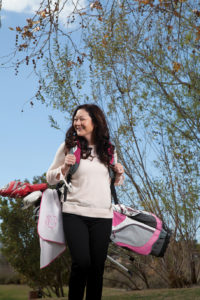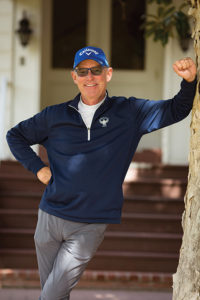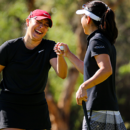Different Strokes: Meet Some of the Top Golf Instructors in SoCal

The golf swing. Lee Trevino once complained, “My swing is so bad, I look like a caveman killing his lunch.” John Updike remarked, “The golf swing is like a suitcase into which we are trying to pack one too many things.” Watch 100 players and you’re likely to see 100 different golf swings. Some swings are more successful than others, to be sure, but even the best among us are constantly trying to improve. And just as no two swings are the same, there are many ways to teach the game, and many aspects of the game to teach. On the following pages, we introduce some of the most respected experts in the world of golf instruction. As world renowned sports phycologist Bob Rotella said, “Golf is not a game of perfect,” but you’ll likely find that these folks can help you get just a little closer.

Dave Stockton Jr.
Rancho Santa Fe
The big moment for Dave Stockton Jr. came in 2009, when his father was asked by Phil Mickelson to help him with his putting. Father and son traveled to Rancho Santa Fe together and spent a couple of days simplifying the putting stroke of one of the world’s best golfers.
The next week, Mickelson won the TOUR Championship.
“My dad and I looked at each other and thought, maybe this is something we should do,” said Stockton, who had been working in real estate after his playing career ended in 2004. “And that’s how it started.”
They formed Stockton Golf, and since then the number of golfers who have benefited from their instruction, especially in the short game, has been off the charts.
Stockton the elder, at 77, is backing off on his schedule a bit, but Junior, as he’s often called, is going full speed. He works with golfers of all ages and abilities, travels with his father to give clinics at clubs around the country, and tries to do for every player what he and his father did for Mickelson.
“To help them improve in a part of the game where they’ve stumbled for years is a real kick,” Stockton said. “I think I’ve found my calling.”
Stockton takes pride in that TOUR players he and his father have worked with have amassed more than 100 wins since working with them, and he takes equal pride in working with youngsters.
During the CareerBuilder Challenge in January, he caddied for one of his longtime pupils, 18-year-old amateur Charlie Reiter, who had been given an exemption into the event. “I started with him when he was 10,” Stockton said. “And here he is with a phenomenal resume. He has the potential to be a star on the TOUR.”
Stockton has moved his base of operations from the desert to Del Mar Country Club, where he designed a short-game facility a few years ago, though he travels extensively for clinics and to work with TOUR players. He also works with Back Nine Greens, and has helped launch a luxury division that builds elaborate synthetic green complexes.
 Joe Grohman
Joe Grohman
Cypress
Joe Grohman ran a nationally recognized junior program at the Navy Golf Course in Cypress, one that received Navy Best Practice distinction when evaluated against other operations worldwide. It’s part of the reason that Grohman was given the 2017 Youth Development Award from the Southern California PGA.
Twenty years ago he was asked by Long Beach Memorial Hospital to give a clinic to stroke victims. That moment changed his life, and many other lives as well. Since that time, he has spent endless hours — mostly of his own time — conducting golf clinics at multiple sites for the blind, for people with special needs, inner-city and troubled kids, disabled veterans and Wounded Warriors.
“There’s no better rehabilitative therapy than golf,” said Grohman, the SCPGA’s Professional of the Year in 2013.
He began working with Wounded Warriors 10 years ago and, among many other clinics around the nation, holds monthly clinics at Camp Pendleton. Early on, one young Marine attended a clinic, seemed excited and a month later returned. He told Grohman that he had been on the verge of committing suicide, but that he had been to the course every day in between the
clinics.
“He said, ‘I have to tell you, this little clinic saved my life,’” Grohman recalled. “That really had an impact.”
▪ joegrohmangolffoundation.org
 Josh Alpert
Josh Alpert
El Segundo
You can tell immediately — this guy is all about fun. Whether it’s the colorful putting guide cones, the intriguing swing path training aids or his affectionate and bubbly personality, taking a lesson at The Lakes at El Segundo with Josh Alpert and his staff is voluntarily entering the fun zone.
Alpert has been at The Lakes for over 20 years now, working his way from the golf shop to assistant instructor to running his own Good Swings Happen Junior Golf Academy out of the facility.
“We try and keep everything as fun as we can for as long as we can,” said Alpert. “It’s just that simple.”
Alpert brings good vibes to the instruction area not only in the form of eye-appealing drills, but also works with his players on boiling down larger golf thoughts into smaller competitions, such as turning a putting drill into a lesson on course management.
“I have students from ages 4 or 5 up to a 90-year-old woman,” he said. “Creating fun set ups works for the young and the old and everyone inbetween. Having fun is good for the game.”
Alpert’s Good Swings Happen academy is committed to supporting the game of golf at a larger level — it’s yearlong programming for juniors in the surrounding community. Alpert also works with SCGA Junior for cosponsored competitions, joint clinics and the general betterment of the game.
 Mark Harradine
Mark Harradine
Ojai
Mark Harradine grew up a tennis player, competing on the professional tours before deciding it wasn’t a longterm investment. Born and bred in Sydney, Australia, Harradine admittedly suffered from a bit of a bad temper and wanted to figure out how to control his emotions and overall headspace.
After a deep dive into psychology and its marriage with athletes, Harradine established his sports mental coaching outlet, Conscious Athletes, in 2005 and within two years was working with a top-5 golfer in the world.
“I strive to teach my clients how to trust their swings under pressure,” he said. “Whether they’re competing on TOUR or for a $10 skins game, it’s still the same philosophy.”
Harradine acknowledges three common mental lapses among his amateur clients and works with them to approach the game differently.
First, when lining up for a tee shot, he stresses the importance of viewing the target on a macro level. Instead of aiming at the right side of the fairway, lining up at the mountaintop or cloud in the distance will relieve pressure.
Secondly, knowing the course before you play is paramount. The pros have caddies, but amateurs have a computer. He stresses viewing a flyover or even just looking at the scorecard the night before.
Finally, Harradine wants you to just play your swing. If you’re a slicer, aim left! Play what you know and the swing you have that day. Play within yourself and don’t make adjustments on the course. The range is for those major changes.
 Seiko Onoue Matsumura
Seiko Onoue Matsumura
Mission Viejo
You can spot her three or four afternoons a week on the practice areas at Arroyo Trabuco GC in Mission Viejo. She’s the one surrounded by kids playing all sorts of games to learn about golf and life. Most of the time, the youngsters will have the same beaming smile that seems to always highlight their teacher’s face.
Seiko Onoue Matsumura is a 33-year-old PGA member who spends up to 90 percent of her teaching time working with juniors. A 2006 graduate of USC who has been at Arroyo Trabuco since 2009, she focuses on keeping the kids engaged, rewarding them with badges for all things golf-related. She keeps her lessons focused on moving forward and having fun.
“I love working with kids,” she said. “When they say, ‘Oh my gosh, I shot my best round,’ or ‘I’m going to my first AJGA event,’ it’s just so fulfilling.”
She gets to know her students, what their hobbies are, their likes and dislikes, how much time they’ll have to practice, and she creates individualized plans for them that help them not only during her clinics and lessons, but when they’re on their own.
“When I started teaching,” she said, “I was always results-oriented. I focused on just golf stuff. But as I mature myself, I think of it more as life lessons, learning about the student, learning how to teach them what they have to do to respond to what’s in front of them rather than reacting to what you just did. Life is too short to have bad days.”
 Heidi Richardson
Heidi Richardson
Encinitas
It’s not technically her office, but the practice facility at the north end of the driving range at Encinitas Ranch GC is where Heidi Richardson spends four or five hours a day, five or six days a week. It’s her haven, where juniors, beginners, women and aspiring players go to hone their games and catch some of the boundless enthusiasm that Richardson brings to golf.
Richardson has been at Encinitas Ranch since it opened in 1998. She runs the USGA/LPGA girls golf program at at the facility, is heavily involved in junior golf in the area, runs summer camps, is introducing yoga into her teaching and is preparing for the third annual Women’s Golf Festival in her continuing effort to bring more people into the game. She received the SCPGA Youth Development Award in 2016, and in 2017 was given the San Diego chapter’s Player Development Award.
She’s been playing golf since she was 5 years old, was the only girl on the La Jolla High School team and then played at UCLA. But a few years ago, she decided that she wanted to remember what it was like to be a beginner, to struggle to hit even the most basic shots. She thought it might help her relate to players just getting started.
So she began playing left-handed, and she’s continued to do so.
“I’m not breaking par, but I’m about a bogey golfer,” she said. “I’m pretty happy with that.”
She’s also somehow finding time to play more chapter events competitively, which has been a goal for some time. She’s sticking to right-handed in those, though.
 Bob Madsen
Bob Madsen
Sycuan
As Director of Instruction at Sycuan Golf Resort since 1991, Bob Madsen has been on a crusade during the thousands of hours he’s worked with students to free their minds of the clutter that he sees afflicting so much golf instruction.
Rather than devote all his time working on swing plane or shoulder turn or forward presses, he uses games, drills and exercises in his lessons — the vast majority of which are on the 54 holes at Sycuan rather than the range — to help his students reach the goals they’ve established together.
Of course, when a swing is so flawed it stunts progress, that gets Madsen’s attention. But much of his energy is spent clearing his students’ minds of the things that are preventing them from playing freely and creatively.
“I probably do less swing analysis and overhaul than any other teacher in Southern California,” said Madsen, the SCPGA Teacher of the Year for 2017. “When people come to me, they’re going to get a golf lesson rather than a swing lesson.”
Not long ago, a dentist who was shooting in the 80s retired and began earnestly trying to improve. He worked with a couple of instructors who gave him so much mechanical information that he couldn’t break 90 and considered quitting. He’s now working with Madsen. In their initial discussion, Madsen said, “I pulled 21 swing thoughts out of him that he had been working on. We’re stripping that stuff away.”











